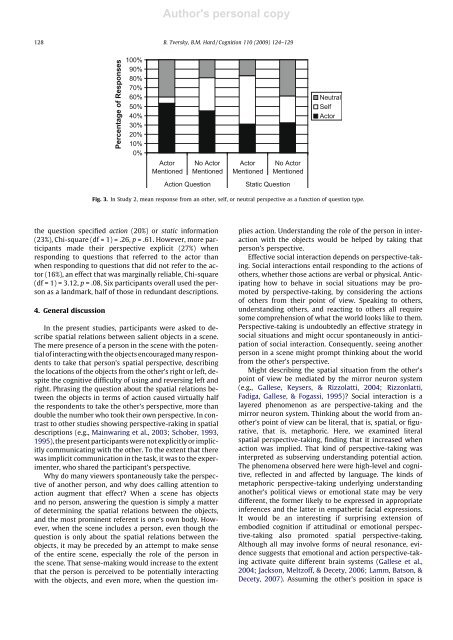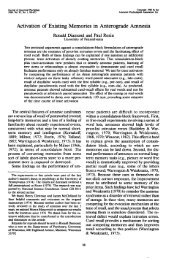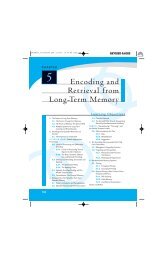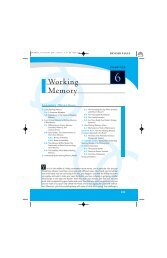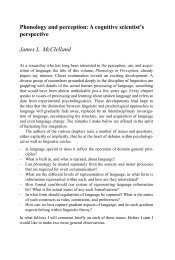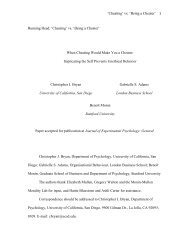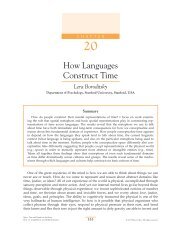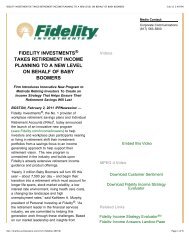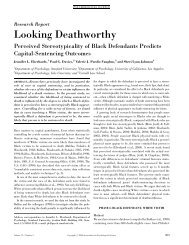Embodied and disembodied cognition: Spatial perspective-taking
Embodied and disembodied cognition: Spatial perspective-taking
Embodied and disembodied cognition: Spatial perspective-taking
Create successful ePaper yourself
Turn your PDF publications into a flip-book with our unique Google optimized e-Paper software.
the question specified action (20%) or static information<br />
(23%), Chi-square (df = 1) = .26, p = .61. However, more participants<br />
made their <strong>perspective</strong> explicit (27%) when<br />
responding to questions that referred to the actor than<br />
when responding to questions that did not refer to the actor<br />
(16%), an effect that was marginally reliable, Chi-square<br />
(df = 1) = 3.12, p = .08. Six participants overall used the person<br />
as a l<strong>and</strong>mark, half of those in redundant descriptions.<br />
4. General discussion<br />
100%<br />
90%<br />
80%<br />
70%<br />
60%<br />
50%<br />
40%<br />
30%<br />
20%<br />
10%<br />
0%<br />
In the present studies, participants were asked to describe<br />
spatial relations between salient objects in a scene.<br />
The mere presence of a person in the scene with the potential<br />
of interacting with the objects encouraged many respondents<br />
to take that person’s spatial <strong>perspective</strong>, describing<br />
the locations of the objects from the other’s right or left, despite<br />
the cognitive difficulty of using <strong>and</strong> reversing left <strong>and</strong><br />
right. Phrasing the question about the spatial relations between<br />
the objects in terms of action caused virtually half<br />
the respondents to take the other’s <strong>perspective</strong>, more than<br />
double the number who took their own <strong>perspective</strong>. In contrast<br />
to other studies showing <strong>perspective</strong>-raking in spatial<br />
descriptions (e.g., Mainwaring et al., 2003; Schober, 1993,<br />
1995), the present participants were not explicitly or implicitly<br />
communicating with the other. To the extent that there<br />
was implicit communication in the task, it was to the experimenter,<br />
who shared the participant’s <strong>perspective</strong>.<br />
Why do many viewers spontaneously take the <strong>perspective</strong><br />
of another person, <strong>and</strong> why does calling attention to<br />
action augment that effect? When a scene has objects<br />
<strong>and</strong> no person, answering the question is simply a matter<br />
of determining the spatial relations between the objects,<br />
<strong>and</strong> the most prominent referent is one’s own body. However,<br />
when the scene includes a person, even though the<br />
question is only about the spatial relations between the<br />
objects, it may be preceded by an attempt to make sense<br />
of the entire scene, especially the role of the person in<br />
the scene. That sense-making would increase to the extent<br />
that the person is perceived to be potentially interacting<br />
with the objects, <strong>and</strong> even more, when the question im-<br />
Author's personal copy<br />
128 B. Tversky, B.M. Hard / Cognition 110 (2009) 124–129<br />
Percentage of Responses<br />
Actor<br />
Mentioned<br />
No Actor<br />
Mentioned<br />
Actor<br />
Mentioned<br />
No Actor<br />
Mentioned<br />
Action Question Static Question<br />
Neutral<br />
Self<br />
Actor<br />
Fig. 3. In Study 2, mean response from an other, self, or neutral <strong>perspective</strong> as a function of question type.<br />
plies action. Underst<strong>and</strong>ing the role of the person in interaction<br />
with the objects would be helped by <strong>taking</strong> that<br />
person’s <strong>perspective</strong>.<br />
Effective social interaction depends on <strong>perspective</strong>-<strong>taking</strong>.<br />
Social interactions entail responding to the actions of<br />
others, whether those actions are verbal or physical. Anticipating<br />
how to behave in social situations may be promoted<br />
by <strong>perspective</strong>-<strong>taking</strong>, by considering the actions<br />
of others from their point of view. Speaking to others,<br />
underst<strong>and</strong>ing others, <strong>and</strong> reacting to others all require<br />
some comprehension of what the world looks like to them.<br />
Perspective-<strong>taking</strong> is undoubtedly an effective strategy in<br />
social situations <strong>and</strong> might occur spontaneously in anticipation<br />
of social interaction. Consequently, seeing another<br />
person in a scene might prompt thinking about the world<br />
from the other’s <strong>perspective</strong>.<br />
Might describing the spatial situation from the other’s<br />
point of view be mediated by the mirror neuron system<br />
(e.g., Gallese, Keysers, & Rizzolatti, 2004; Rizzonlatti,<br />
Fadiga, Gallese, & Fogassi, 1995)? Social interaction is a<br />
layered phenomenon as are <strong>perspective</strong>-<strong>taking</strong> <strong>and</strong> the<br />
mirror neuron system. Thinking about the world from another’s<br />
point of view can be literal, that is, spatial, or figurative,<br />
that is, metaphoric. Here, we examined literal<br />
spatial <strong>perspective</strong>-<strong>taking</strong>, finding that it increased when<br />
action was implied. That kind of <strong>perspective</strong>-<strong>taking</strong> was<br />
interpreted as subserving underst<strong>and</strong>ing potential action.<br />
The phenomena observed here were high-level <strong>and</strong> cognitive,<br />
reflected in <strong>and</strong> affected by language. The kinds of<br />
metaphoric <strong>perspective</strong>-<strong>taking</strong> underlying underst<strong>and</strong>ing<br />
another’s political views or emotional state may be very<br />
different, the former likely to be expressed in appropriate<br />
inferences <strong>and</strong> the latter in empathetic facial expressions.<br />
It would be an interesting if surprising extension of<br />
embodied <strong>cognition</strong> if attitudinal or emotional <strong>perspective</strong>-<strong>taking</strong><br />
also promoted spatial <strong>perspective</strong>-<strong>taking</strong>.<br />
Although all may involve forms of neural resonance, evidence<br />
suggests that emotional <strong>and</strong> action <strong>perspective</strong>-<strong>taking</strong><br />
activate quite different brain systems (Gallese et al.,<br />
2004; Jackson, Meltzoff, & Decety, 2006; Lamm, Batson, &<br />
Decety, 2007). Assuming the other’s position in space is


